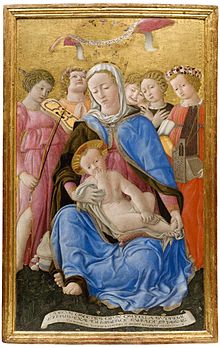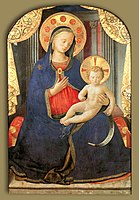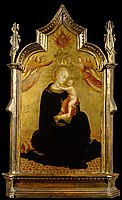Madonna of humility

Madonna of humility refers to artistic portrayals of the Virgin Mary which depict her sitting on the ground, or upon a low cushion. She may be holding the Christ Child in her lap.[1] The term Virgin of humility is also used to refer to this style of depiction. The iconography originated in the 14th century, and was most common in that and the following century.
History and development
The earliest known painting of this type dates to 1346 and is at the Museo Nazionale in
An altar was dedicated to the Madonna of humility in the church of Santa Maria Novella in Florence in 1361.[8] This style of painting spread quickly through Italy and by 1375 examples began to appear in Spain, France and Germany. It was the most popular among the depictions of the early Trecento artistic period.[6]
Examples

Domenico di Bartolo's Madonna of Humility, painted in 1433, was described by art historian Andrew Ladis as one of the most innovative devotional images of the early Renaissance.[9] The formal symmetry of the strips below her feet and those hovering above her symbolize the harmony of her human nature and status as an earthly woman, with her heavenly queenship. Despite the low seating position, the star and the gems as well as the halo signify her regal status.[9] In this painting, which is at the Pinoteca Nazionale in Siena, Domenico did not use cast shadows as he did in other works such as the Madonna Enthroned.[10]
Filippo Lippi's Madonna of Humility, painted between 1431 and 1437, is also an important work and illustrates Lippi's early style, when he was attentive to Masaccio's use of large and round figures. It was painted during a period when Lippi had dropped out of sight, and had perhaps gone into exile with Cosimo de' Medici.[11]
A miracle attributed to the fresco of the Madonna of Humility painted in circa 1370 gave rise to the construction of the
Other key examples include Bernardo Daddi's central panel in the De Carlo Triptych in which the Madonna is shown sitting in a very low chair, rather than on a cushion.[14] Fra Angelico's representation of about 1430 (which includes two angels) is notable in that Jesus is approached from above, focusing on his divinity.[15] Giovanni di Paolo's depiction of about 1456 (see gallery below) represents a transition in the perception of nature, with the visual landscape forming itself around the seated Madonna.[16]
Feast

The feast of the Humility of the Blessed Virgin Mary was on July 17.[17][18][19] It was included in the General Roman Calendar of 1954 among the feasts pro aliquibus locis (in some places), but was removed from the General Roman Calendar of 1960.
Upon the election of
Gallery
-
Fra Angelico, c. 1430.
-
Lorenzo Monaco, c. 1410
-
Sano di Pietro c. 1440
-
Andrea di Bartolo, c. 1410
-
Sassetta, ca. 1445–1450
-
Giovanni di Paolo, c. 1456
See also
References
| Part of a series on the |
| Mariology of the Catholic Church |
|---|
 |
|
Catholicism portal |
- ISBN 0-313-24658-0page 174
- ^ Williamson, Beth (2009). The Madonna of Humility. Boydell and Brewer. p. 115.
- ISBN 0-06-433317-5page 223
- ^ Iconography of Christian Art by Gertrud Schiller, 1971 ASIN: B0023VMZMA page 112
- ^ Cat. # 1072, Follower of Lippo Memmi per the 1986 catalogue.
- ^ ISBN 0-691-00312-2pages 132–133
- ISBN 1-86011-175-0page 94
- ISBN 0-691-00312-2page 144
- ^ ISBN 0-7546-0689-9 page 15 [1]
- ISBN 0-674-03523-2 page 309 [2]
- ISBN 0-8028-6348-5page 249
- ISBN 0-691-00312-2pages 136
- ISBN 0-310-22573-6 page [3]
- ISBN 88-09-02182-7 page 21 [4]
- ISBN 0-88489-530-0 page 306 [5]
- ISBN 0-8203-2440-X page 170 [6]
- ^ "July 17th: Humility of the Blessed Virgin Mary". Retrieved July 17, 2021.
- ^ Peterson, Larry (July 27, 2018). "The Humility of the Blessed Virgin Mary; This was Her defining Virtue". Catholic 365. Retrieved July 17, 2021.
- ^ Lovasik, S.V.D., Rev. Lawrence G. "Our Lady's Feast Days". EWTN. Retrieved July 17, 2021.
- ISBN 0-271-03406-8page 175
Further reading
- Williamson, Beth, Madonna of Humility: Development, Dissemination and Reception, c. 1340–1400 (Woodbridge, Suffolk: Boydell Press, 2009) (Bristol Studies in Medieval Cultures, 1).






